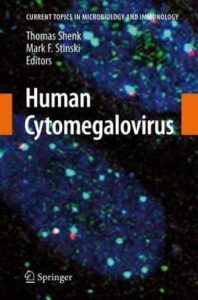نام کتاب: Human Cytomegalovirus
نویسنده: E. Murphy و Thomas E. Shenk و Thomas E. Shenk و Mark F. Stinski
ویرایش: ۱
سال انتشار: ۲۰۰۸
کد ISBN کتاب: ۳۵۴۰۷۷۳۴۸۷, ۹۷۸۳۵۴۰۷۷۳۴۸۱, ۹۷۸۳۵۴۰۷۷۳۴۹۸,
فرمت: PDF
تعداد صفحه: ۴۷۹
حجم کتاب: ۲۲ مگابایت
کیفیت کتاب: OCR
انتشارات: Springer-Verlag Berlin Heidelberg
Description About Book Human Cytomegalovirus From Amazon
The earliest observation of cytomegalovirus (CMV) interactions with the host cell was owl eye cytopathology in various tissues. It was recognized in the early 1970s that human CMV caused in utero infections resulting in congenital brain damage and other sensory neurological complications. Events of the 1980s and early 1990s, such as the wide application of solid organ and bone marrow transplantation and the emergence of AIDS, put the spotlight on human CMV. We understood that the virus was an opportunistic agent associated with immunosuppression. The golden age of cytomegalovirus research was ushered in during the late 1970s and early 1980s by a set of powerful new technologies that included restriction enzymes, DNA cloning, DNA sequencing, and open reading frame prediction. The genetic manipulation and propagation of novel CMV strains was accelerated with the app- cation of bacterial artificial chromosome technology. Today, we still struggle to understand the full spectrum of disease associated with human CMV. To the molecular biologist, CMV is a master of regulation in the eukaryotic cell where it either replicates or remains latent. To the immunologist, CMV is a master of immune evasion with tools to escape both the innate and acquired immune responses. The use of animal models with non-human CMVs has become significantly more sophisticated and tied to a more certain understanding of the interrelationships of non-human and human CMV genes.
درباره کتاب Human Cytomegalovirus ترجمه شده از گوگل
اولین مشاهده اثرات متقابل سیتومگالوویروس (CMV) با سلول میزبان ، سیتوپاتولوژی چشم جغد در بافتهای مختلف بود. در اوایل دهه ۱۹۷۰ تشخیص داده شد که CMV انسان در عفونت های رحمی و در نتیجه آسیب مادرزادی مغز و سایر عوارض عصبی حسی ایجاد می کند. وقایع دهه ۱۹۸۰ و اوایل دهه ۱۹۹۰ ، مانند استفاده گسترده از پیوند اعضا solid جامد و مغز استخوان و ظهور ایدز ، کانون توجه CMV انسان است. ما درک کردیم که ویروس یک عامل فرصت طلب همراه با سرکوب سیستم ایمنی است. عصر طلایی تحقیقات سیتومگالوویروس در اواخر دهه ۱۹۷۰ و اوایل دهه ۱۹۸۰ توسط مجموعه ای از فن آوری های جدید قدرتمند که شامل آنزیم های محدود کننده ، شبیه سازی DNA ، تعیین توالی DNA و پیش بینی قاب بازخوانی بود ، آغاز شد. دستکاری ژنتیکی و انتشار سویه های جدید CMV با استفاده از فناوری کروموزوم مصنوعی باکتری تسریع شد. امروز ، ما هنوز در درک طیف کاملی از بیماری های مرتبط با CMV انسان تلاش می کنیم. از نظر زیست شناس مولکولی ، CMV استاد تنظیم در سلول یوکاریوتی است که در آن تکثیر می شود یا به صورت نهفته باقی می ماند. از نظر ایمونولوژیست ، CMV استاد فرار از سیستم ایمنی با ابزارهایی برای فرار از پاسخهای ایمنی ذاتی و اکتسابی است. استفاده از مدل های حیوانی با CMV های غیر انسانی به طور قابل توجهی پیچیده تر شده و به درک دقیق تری از روابط متقابل ژن های CMV غیر انسانی و انسانی گره خورده است.
[box type=”info”]![]() جهت دسترسی به توضیحات این کتاب در Amazon اینجا کلیک کنید.
جهت دسترسی به توضیحات این کتاب در Amazon اینجا کلیک کنید.![]() در صورت خراب بودن لینک کتاب، در قسمت نظرات همین مطلب گزارش دهید.
در صورت خراب بودن لینک کتاب، در قسمت نظرات همین مطلب گزارش دهید.

